These Aren’t Carrots: Don’t Go Hungering for Hemlocks
Hemlock has bored its way through time and space, showing up in everything from famous Greek executions to cultural hunting tactics to countryside family frolicks gone heartbreakingly wrong. In 21st century life in Minnesota, though, do we know what we’re speaking of when we speak on Hemlock? Here, I intend to get the facts straight.
Which Hemlock?
Minnesota has three kinds of toxic hemlock: Water Hemlock (Cicuta maculata), Bulblet-bearing Water Hemlock (Cicuta bulbifera), and Poison Hemlock (Conium maculatum). Water Hemlock (Cicuta maculata) and Bulblet-bearing Water Hemlock (Cicuta bulbifera) are native, while Poison Hemlock (Conium maculatum) is non-native.
How do we tell?
First, we must distinguish the three plants botanically and visually. All are members of the carrot/parsnip family, Apiaceae, and thus look similar in appearance to other species in this group. All have flat, white umbels and hollow stems. Both Water Hemlock and Poison Hemlock have purple spots/splotches.
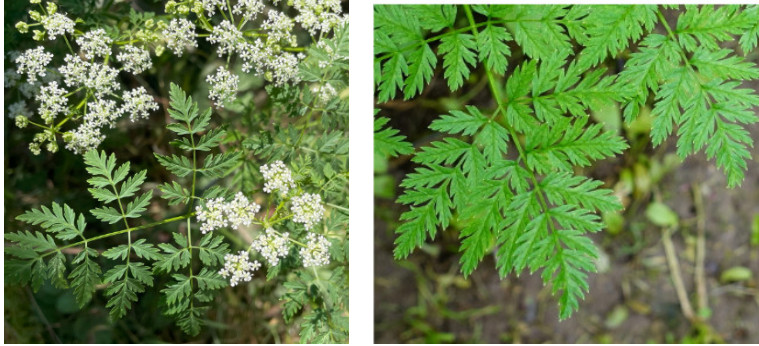
Poison Hemlock
- Poison Hemlock (Conium maculatum) is a biennial. In the first year of growth, Poison Hemlock produces a large rosette of leaves near the ground. The second year, it grows a tall, smooth and hairless stem, reaching a height of 6-10 feet. Alternate leaves are large, glossy green, and 2 to 4 times compound, with larger teeth than Water Hemlock. Poison Hemlock’s thick, white taproot is very similar to Wild Parsnip’s. Leaves are fern-like, often called “lacy”, quite similar to those leaves of Queen Anne’s Lace/Wild Carrot (Daucus carota) and Japanese Hedge Parsley (Torilis japonica), though these latter two plants have bracts beneath their umbels—Daucus carota large, showy bracts, and Torilis japonica smaller, narrower bracts.
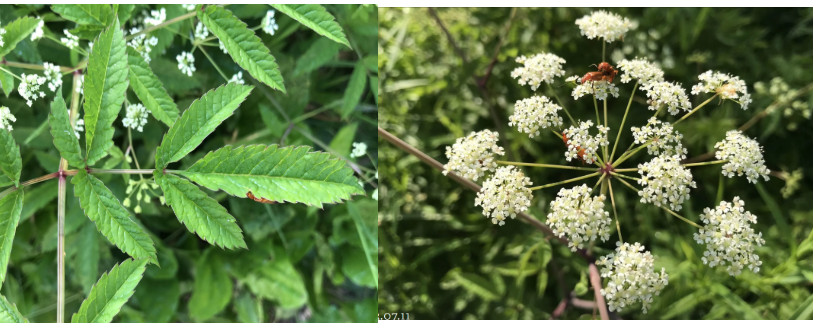
Water Hemlock
- Water Hemlock (Cicuta maculata in the Midwest, with the basically identical plant Cicuta douglasii in the far Western states) is a perennial. Water Hemlock is distinguished by its very bulbous, hollow root, as well as leaves that divide 1 to 3 times into 1 to 4-inch-long feather-like narrow-toothed leaflets. Some people mistake Water Hemlock for Water Parsnip, but the leaves of the latter, Sium suave, are singly compound, not doubly compound. Most notably, Water Hemlock’s leaflet veins run out from the central vein to the notch of the leaf’s teeth rather than the tip. Also, leaves are more pointed and slightly fold up onto themselves. Smooth stems are very branched. Water Hemlock grows 3-6 feet.
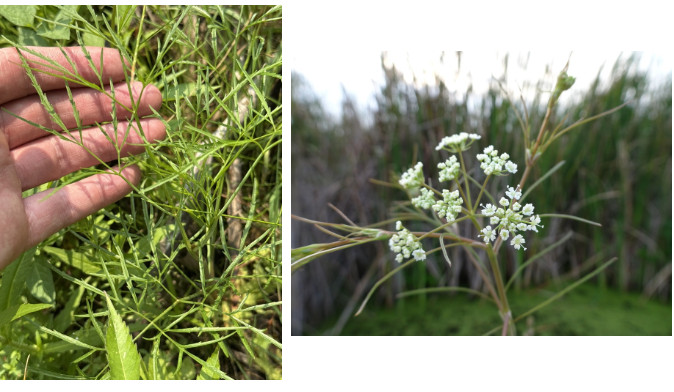
Bulblet-bearing Water Hemlock
- Bulblet-bearing Water Hemlock (Cicuta bulbifera) is most easily distinguished by its namesake: tiny bulbils near the leaf axils. Additionally, this hemlock has very narrow, blade-like light green leaves—rather than large lacy leaflets—and widely spaced teeth. Leaves are compound and shrink as they ascend the stem. Stems are branched and hairless. Roots are in a fleshy cluster. Bulblet-bearing Water Hemlock grows 1-4 feet.
When do they flower?
Water Hemlock and Poison Hemlock flower June through August, while Bulblet-bearing Water Hemlock blooms July through September. Queen Anne’s Lace (Wild Carrot), a non-toxic look-alike, also flowers July through September.
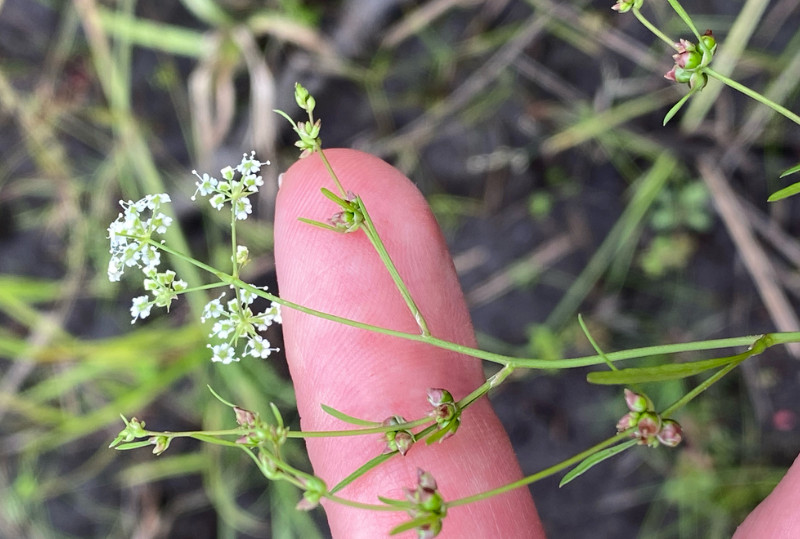
Bulblet-bearing Water Hemlock
How do they spread?
Water Hemlock self-propagates by seeds and tubers; Poison Hemlock just spreads through seeds. Bulblet-bearing Water Hemlock reproduces by seeds and aerial bulblets.
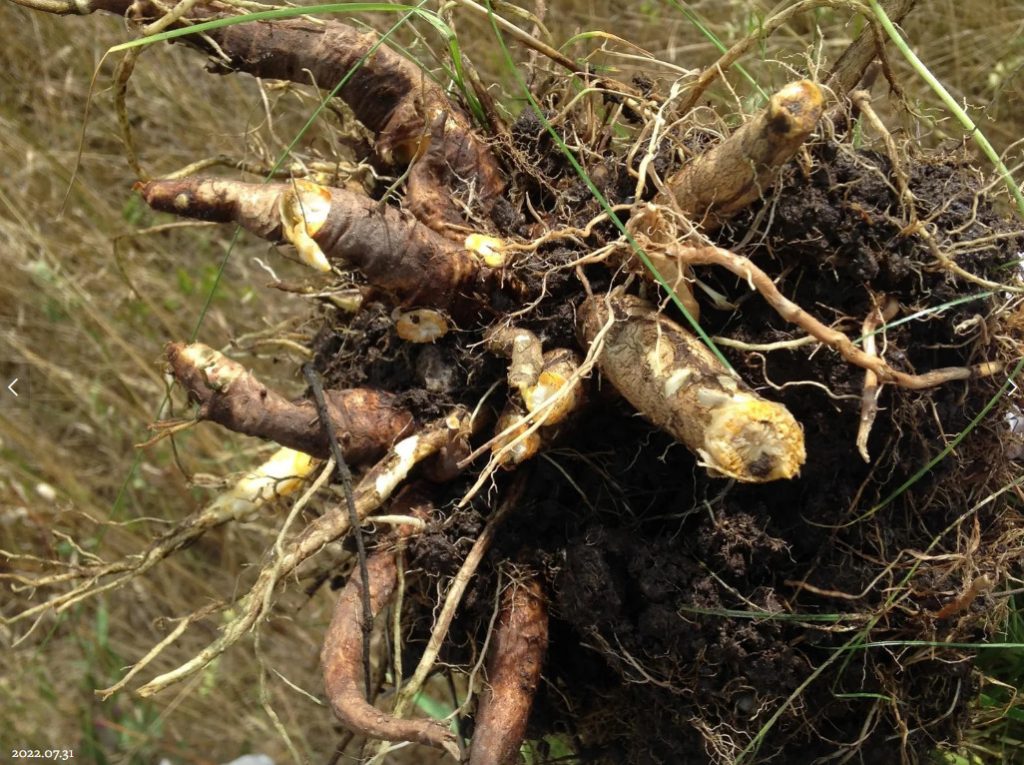
Water Hemlock tubers
What are their prospective habitats?
Water Hemlock, per its name, grows in partial or full sun near water: along ditches, streambeds, pond edges, swamps, fens, and in the low-lying, wet areas of pastures and meadows. Bulblet-bearing Water Hemlock also likes wet areas with slow-moving water: sunny, undisturbed wetlands, lakes, and ponds. Poison Hemlock also grows in marginal and disturbed areas with moist soil, but it can tolerate drier sites. It inhabits roadsides, utility corridors, ditches, fence rows, abandoned fields, railroads, and, like its sibling, in streams, meadows, marshes, and wetlands. Poison Hemlock prefers very open areas with full sun, but it can adapt to slightly shaded areas.
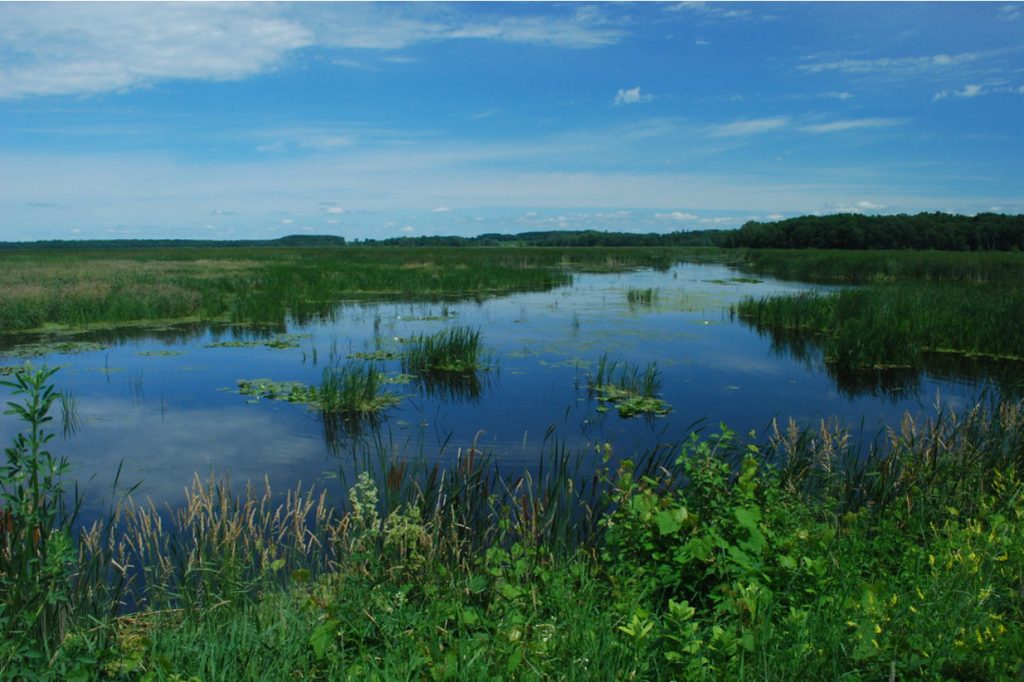
A fen where hemlock could thrive
Which parts of each are poisonous?
- Poison Hemlock: All parts of Poison Hemlock are poisonous. The plant may cause skin irritation just by contact. It contains eight known toxic alkaloids, as opposed to Water Hemlock, which contains one chief toxin: cicutoxin. Poison Hemlock leaves are especially poisonous in the spring.
- Water Hemlock: All parts are toxic, but especially the roots and tubers, which are the primary locations of the highly toxic substance cicutoxin. Broken roots/tubers exude a brownish, turnip-smelling liquid with a high concentration of this substance.
- Bulblet-bearing Water Hemlock: All parts are toxic, but especially the roots and shoots.
Comparing Toxicity

For any animal, human or non-human, early signs of poisoning by all hemlocks include pupil dilation, excessive and frequent urination, rapid heartbeat, low blood pressure, nervous trembling, confusion, salivation, abdominal pain, bloating, and loss of coordination. For those who survive poisoning, long-term effects may include renal failure, severe metabolic acidosis, bradycardia, permanent hypotension, and even retrograde amnesia.
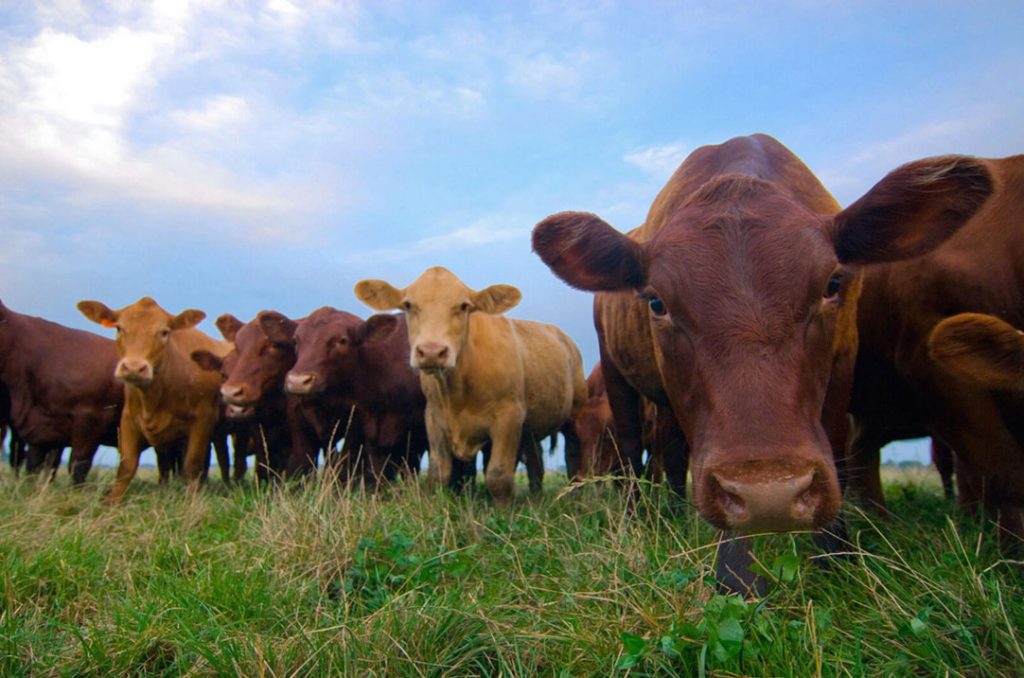
Thankfully, livestock tend to avoid hemlock. However, if there is not much food available or hemlock enters the feed, animals may consume it. Oddly enough, in the period immediately after herbicide is applied, Water Hemlock increases in palatability. Thus, farmers must be sure to eradicate hemlock from the property and feed, especially in the weeks following herbicide treatment.
Poison Hemlock can cause gastrointestinal, respiratory, central nervous system, and reproductive effects if ingested. All three hemlocks cause acute poisoning; however, Poison Hemlock, because it is less toxic, may instead build up in an animal’s system over time if small enough amounts are eaten frequently. Thus, farmers can’t be too vigilant. 4-8 ounces of green leaves will kill a sheep and 10-15 ounces will kill cattle in around 1-3 hours. 150-300 milligrams of Poison Hemlock, about six to eight leaves, is fatal to humans. For any animal, Poison Hemlock eventually leads to respiratory paralysis; the animal suffocates to death.

With both kinds of Water Hemlock—Cicuta maculata and Cicuta bulbifera—the most prominent effect is the attack on the central nervous system; convulsions are a telltale sign of poisoning. Water Hemlock ingestion tends to cause vomiting early on (which may save the victim, though individuals should not attempt to induce vomiting). These plants are extremely powerful. Accordingly, Water Hemlock has killed cows who have crushed roots beneath their hooves, releasing the liquid. In fact, according to Scott Dugan, “it only takes a piece of the [water hemlock] root the size of a walnut to kill a 1,200-pound cow or horse.” 3.5 oz, or a a 2-3-cm portion of the root, is a fatal dose to humans. The same is true of Cicuta bulbifera. Children have perished making toy whistles of the roots. Typically, the two Water Hemlock(s) eventually induce massive seizures of the brain or cardiopulmonary arrest, causing death.
Again, if it looks like hemlock, don’t hem and haw. Get away.
What to do if hemlock poisoning occurs?
Unfortunately, there’s not much one can do until the victim gets to the emergency room. If you’ve ingested any hemlock, it will probably harm your system; do not assume you’ve ingested a small enough amount. Find the nearest hospital possible. Symptoms can last for weeks to even months afterward.
What should you do to protect yourself…?
If you are entering disturbed, wet areas, look for and steer clear of any hemlock. Keep children and pets away, and better yet, teach them what hemlock looks like and why to avoid it themselves, especially if you live near a hemlock-friendly habitat.
Against Poison Hemlock?

Poison Hemlock rosette (perfect for herbicide treatment)
If Poison Hemlock is on your property, remove it as soon as possible. You can dig up the plants, including the tap roots. Herbicides are most effective the first year of growth, but may also be applied the second year before flowering in early spring or late fall. Mowing can reduce seed production; however, it doesn’t kill the plant entirely, may further spread seed, and kicks up toxic particles (wear eyewear and a mask if mowing). Be sure to clean the mower afterward. However you eradicate it, wear gloves, long sleeves, long pants, socks, and shoes to protect yourself, and take care to clean all of these items thoroughly afterward. Do not burn Poison Hemlock, as that can cause inhalation poisoning. Professional opinions are mixed, so it’s best to throw plants in the garbage rather than in yard waste/compost.
Against Water Hemlock?
Water Hemlock, despite being poisonous, is an ecologically desirable species. As such, we need to look at it not just from the standpoint of our own bodily health and economic gain, but from a broader perspective. Many such species—harmful, yet helpful—exist in complex, critical relationships with other plants and animals: feeding them, enhancing their conditions, curbing their nutrient use so they don’t dominate, housing their pollinators, etc. Thus, plants like Water Hemlock ensure the continued biodiversity of the area, which strengthens the area’s resources against problems that ultimately affect us and/or our agricultural products, such as water degradation and erosion. In this vein, for the good of the many plants, animals, insects, and fungi we love and that benefit us, Water Hemlock should be left alone. Unless Water Hemlock is in such a place that it will most definitely harm your loved ones or livestock, do not pull, mow, etc. If it is in such a place, follow the suggested management of Poison Hemlock.
What should naturalists do to manage and/or warn visitors?

Signs and handouts at trailheads and at known hemlock sites may tip visitors who don’t know what hemlock looks like and/or have dogs off. Signs should include the hemlocks’ appearance and habitat, as well as symptoms of poisoning.
Management-wise, synthetic auxin herbicides such as 2,4-D, dicamba, clopyralid and triclopyr will selectively control Poison Hemlock, leaving graminoids unaffected. Glyphosate or any other broad-spectrum herbicide may be used in non-vulnerable or sparse areas. Again, herbicide applications that target rosettes in the early spring (before flowering) can be very effective. Otherwise, as mentioned above, careful mowing and pulling are reasonable options.
Photo Credits+
In order:
Poison Hemlock: Amanda Kat (left) and Alexander Baransky (right)
Water Hemlock: Byron Murray
Bulblet-bearing Water Hemlock: iNat user “charlie” (first), iNat user “sls42” (second)
Bulblet-bearing Water Hemlock bulblets: Erik Erbes
Water Hemlock tubers: Byron Murray
Fen: Joshua Mayer
Hemlock Poisoning Symptoms (clockwise):
https://commons.wikimedia.org/wiki/File:Blood_pressure_measurement_%282009%29.jpg
https://loncarlyonjenkins.com/hernia-mesh-lawsuit-lawyer/can-hernia-mesh-upset-your-stomach
https://www.eroftexas.com/tachycardia
https://commons.wikimedia.org/wiki/File:Confused_young_woman.jpg
Convulsions: Lybrate.com
Stay-on-Trail Sign: National Park Service
References+
Anderson, Eric, Isabel Branstrom, and Erin Hill. “Poison Hemlock Identification and Control.” MSU Extension Agriculture, Michigan State University Extension, April 20, 2023. https://www.canr.msu.edu/news/poison-hemlock-identification-and-control.
ARS. “Water Hemlock (Cicuta Douglasii).” Agricultural Research Service USDA, USDA, 2018. https://www.ars.usda.gov/pacific-west-area/logan-ut/poisonous-plant-research/docs/water-hemlock-cicuta-douglasii/.
Behnke, Doris. “Poison Hemlock Identification and Management | University of Maryland Extension.” Agronomy News 12, no. 4 (November 2024). https://extension.umd.edu/resource/poison-hemlock-identification-and-management.
Calspace. “Water Hemlock.” Calscape.Org, California Native Plant Society. https://calscape.org/Cicuta-maculata-(Water-Hemlock).
Chayka, Katy. “Cicuta Maculata (Water Hemlock): Minnesota Wildflowers.” Minnesota Wildflowers. Accessed July 30, 2025. https://www.minnesotawildflowers.info/flower/water-hemlock.
———. “Conium Maculatum (Poison Hemlock): Minnesota Wildflowers.” Minnesota Wildflowers. Accessed July 30, 2025. https://www.minnesotawildflowers.info/flower/poison-hemlock.
———. “Torilis Japonica (Japanese Hedge Parsley).” Minnesota Wildflowers. Accessed August 6, 2025. https://www.minnesotawildflowers.info/flower/japanese-hedge-parsley.
Cleveland Clinic. “Hemlock Poisoning: Symptoms, Treatment & Prevention.” September 9, 2022. https://my.clevelandclinic.org/health/diseases/24122-poison-hemlock.
Duggan, Scott. “Poison Hemlock and Western Waterhemlock: Deadly Plants That May Be Growing in Your Pasture.” OSU Extension Catalog, June 1, 2018. Southern Willamette Valley Small Farms. https://extension.oregonstate.edu/catalog/pub/poison-hemlock-western-waterhemlock-deadly-plants-may-be-growing-your-pasture.
Evans, Christopher. “Poison Hemlock in Illinois.” With Scott Schirmer and Phil Cox. Illinois Extension, May 2025. https://extension.illinois.edu/sites/default/files/2025-05/accessibledocuments/poison-hemlock.pdf.
Garms, Gabe. “How to Tell the Difference Between Poison Hemlock and Queen Anne’s Lace | Landscapes by Terra.” Landscapes by Terra, Landscapes by Terra. Accessed July 30, 2025. https://landscapesbyterra.com/blog/how-to-tell-the-difference-between-poison-hemlock-and-queen-anne-s-lace.
Guide to Poisonous Plants – College of Veterinary Medicine and Biomedical Sciences – Colorado State University. “Water Hemlock.” Accessed August 6, 2025. https://poisonousplants.cvmbs.colostate.edu/plant/47.
Hassani, Nadia. “Poison Hemlock vs. Queen Anne’s Lace: How to Tell the Difference.” The Spruce, The Spruce, September 30, 2024. https://www.thespruce.com/poison-hemlock-vs-queen-annes-lace-7107563.
Illinois Wildflowers. “Poison Hemlock (Conium Maculatum).” Accessed July 30, 2025. https://www.illinoiswildflowers.info/weeds/plants/poison_hemlock.htm.
King County. “Poison Hemlock Identification and Control.” King County, 2025. https://kingcounty.gov/en/dept/dnrp/nature-recreation/environment-ecology-conservation/noxious-weeds/identification-control/poison-hemlock.
Martinson, Krishona, Lynn Hovda, and Mike Murphy. “Poison and Water Hemlock: Lethal Plants to Horses.” University of Minnesota Extension, 2021. https://extension.umn.edu/horse-pastures-and-facilities/poison-and-water-hemlock-lethal-plants-horses.
McCann, Mary Ann, and Kenneth F. Lampe. AMA Handbook of Poisonous and Injurious Plants. Chicago, Illinois: American Medical Association, 1985. https://archive.org/details/amahandbookofpoi00lamp/page/56/mode/2up.
MDA. “Poison Hemlock.” Minnesota Department of Agriculture. Accessed July 30, 2025. https://www.mda.state.mn.us/plants/pestmanagement/weedcontrol/targetplants/elimtargetplants/poisonhemlock.
Murray, Byron. “Exploring Water Hemlock.” To Know the Land. Accessed August 1, 2025. https://www.toknowtheland.com/blog/exploringwaterhemlock.
Nelson, Lewis S, and Michael J Balick. Handbook of Poisonous and Injurious Plants. 3rd ed. 2020. New York, NY: Springer US, 2020. https://doi.org/10.1007/978-1-4939-8926-3.
Palador. “Poison Hemlock.” Invasive Species Council, n.d. Accessed July 30, 2025. https://invasivespecies.wa.gov/priorityspecies/poison-hemlock/.
Ratz, David. “Poison Hemlock.” Montana Field Guide, July 30, 2025. https://fieldguide.mt.gov/speciesDetail.aspx?elcode=PDAPI0Q010.
Schep, Leo J., Robin J. Slaughter, Gordon Becket, and D. Michael G. Beasley. “Poisoning Due to Water Hemlock.” Clinical Toxicology 47, no. 4 (April 2009): 270–78. https://doi.org/10.1080/15563650902904332.
Sweeney, K, KF Gensheimer, and J Knowlton-Field. Water Hemlock Poisoning — Maine, 1992. 508. CDC, 1994. https://www.cdc.gov/mmwR/preview/mmwrhtml/00026056.htm.
USDA. “Poison Hemlock (Conium Maculatum).” Agricultural Research Service, USDA, 2018. https://www.ars.usda.gov/pacific-west-area/logan-ut/poisonous-plant-research/docs/poison-hemlock-conium-maculatum/.
Vander Ley, Bryan, Bethany Johnston, and Scott Fritz. “Haying and Cattle Grazing Areas with Hemlock | UNL Beef | Nebraska.” University of Nebraska-Lincoln, August 16, 2024. https://beef.unl.edu/beefwatch/2024/haying-and-cattle-grazing-areas-hemlock/.
“Water Hemlock.” United States Department of Agriculture, 2022. https://www.nrcs.usda.gov/sites/default/files/2022-12/WaterHemlock.pdf.
You must be logged in to post a comment.